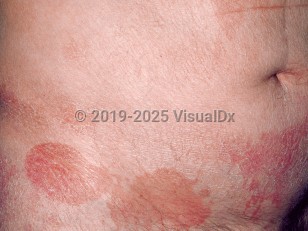Cutaneous T-cell lymphoma in Adult
See also in: Nail and Distal DigitAlerts and Notices
Important News & Links
Synopsis

Mycosis fungoides and its variants (folliculotropic mycosis fungoides, pagetoid reticulosis, and granulomatous slack skin), Sézary syndrome, lymphomatoid papulosis, and cutaneous anaplastic large cell lymphoma make up 90% of all CTCL cases.
This summary focuses on mycosis fungoides and variants and Sézary syndrome. Lymphomatoid papulosis, cutaneous anaplastic large cell lymphoma, and other types of CTCL, such as subcutaneous panniculitis-like T-cell lymphoma, adult T-cell leukemia / lymphoma, and nasal type extranodal NK/T-cell lymphoma, are discussed separately.
Mycosis Fungoides
Mycosis fungoides (MF) is the most common type of CTCL, accounting for 50% of all primary CTCL cases. Erythematous patches and plaques with fine scale and tumors that anatomically favor the buttocks and sun-protected areas of the trunk and limbs characterize this subtype. The etiology remains unclear. Current hypotheses propose that persistent antigenic stimulation occurs, resulting in excessive clonal expansion with the collection of helper memory T cells in the skin. MF takes on an indolent course over years to decades. Associated features include pruritus, poikiloderma, and ulceration of tumors. Extracutaneous involvement correlates with generalized skin involvement and erythroderma. Neoplastic T cells demonstrate a memory T-cell phenotype: CD3+, CD4+, CD45RO+. MF staging requires CTCL physician specialists. Some consider large plaque parapsoriasis to be early patch-stage MF.
MF is approximately twice as common in men as in women, and sex differences in incidence increase with age. In the United States, individuals of African descent have twice the incidence of individuals of Northern European descent, although this difference decreases with age. MF is mostly seen in older adults (median age at presentation is 50-55 years), although individuals in any age group may be affected. Onset of disease may occur before age 40, and this has especially been reported in people of African descent and US women of Hispanic descent. Although the clinical course of MF usually progresses slowly, US patients of African descent, especially women with early-onset disease, have a worse prognosis than other groups.
Hypopigmented MF – A hypopigmented variant of MF is seen primarily in individuals of African descent but has also been reported in those of Asian, Indian, and Latin American descent. This is the most common variant in children.
Folliculotropic MF – Folliculotropic MF (FMF, also known as follicular MF or pilotropic MF) is the most common variant of MF, characterized by lesions on the head and neck clinically and follicular involvement ("folliculotropism") microscopically. Most cases are seen in adult males, but children and adolescents may be affected. Early stage (1A, 1B) disease features patches and plaques with follicular accentuation and keratosis pilaris-like or acneiform lesions, and it may exhibit a better prognosis with an indolent course. These lesions have a predilection for the trunk and extremities. On the other hand, advanced stage (2B) disease with indurated or infiltrative alopecic plaques and tumors may be more aggressive with a poorer prognosis. These lesions favor the head and neck and are more pruritic.
Pagetoid reticulosis – Pagetoid reticulosis, also known as Woringer-Kolopp disease, is a localized variant of MF characterized by a solitary, slow-growing patch or plaque on a distal extremity clinically and striking epidermotropism microscopically. Pagetoid reticulosis has a predilection for middle-aged males but it can be seen in any age group.
Ketron-Goodman disease is a disseminated and aggressive variant of pagetoid reticulosis with a potential for systemic involvement.
Granulomatous slack skin – Granulomatous slack skin, also known as granulomatous dermohypodermitis, is a rare variant of CTCL (< 1% of all cases). It is characterized by asymptomatic, pendulous, loose skin masses in the body folds clinically and granulomatous T-cell infiltration microscopically. The disease may be associated with a lymphoproliferative disorder, such as MF, Hodgkin lymphoma, and non-Hodgkin lymphoma. Males in the third and fourth decades are most commonly affected.
Sézary Syndrome
Sézary syndrome is an aggressive condition with a poor prognosis that accounts for less than 5% of all primary CTCL cases. Erythroderma, generalized lymphadenopathy, and neoplastic T cells (Sézary cells) in the skin and peripheral lymph nodes classically characterize Sézary syndrome. Associated features include severe pruritus, palmoplantar hyperkeratosis, lichenification, edema, and exfoliation. The etiology remains largely unknown. Immunophenotyping demonstrating a CD4:CD8 ratio of > 10, an absolute count of > 1000 Sézary cells per µL, and demonstration of T-cell clonality in the peripheral blood are diagnostic criteria.
Codes
C84.A0 – Cutaneous T-cell lymphoma, unspecified, unspecified site
SNOMEDCT:
400122007 – Primary cutaneous T-cell lymphoma
Look For
Subscription Required
Diagnostic Pearls
Subscription Required
Differential Diagnosis & Pitfalls

Subscription Required
Best Tests
Subscription Required
Management Pearls
Subscription Required
Therapy
Subscription Required
Drug Reaction Data
Subscription Required
References
Subscription Required
Last Updated:09/23/2025
 Patient Information for Cutaneous T-cell lymphoma in Adult
Patient Information for Cutaneous T-cell lymphoma in Adult- Improve treatment compliance
- Reduce after-hours questions
- Increase patient engagement and satisfaction
- Written in clear, easy-to-understand language. No confusing jargon.
- Available in English and Spanish
- Print out or email directly to your patient


